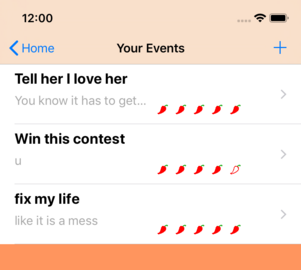Tempo: Difference between revisions
tempo page |
m resize and move image |
||
| Line 3: | Line 3: | ||
== Components == | == Components == | ||
The app was intended to have four components: an iOS and Android app, a backend API, and a Desktop app. The Android app was never developed due to time constraints. The iOS app was written in Swift, the API was written in Rails with Ruby, and the Desktop app was made in Java. Only the API and iOS app ended up having working functionality, however. | The app was intended to have four components: an iOS and Android app, a backend API, and a Desktop app. The Android app was never developed due to time constraints. The iOS app was written in Swift, the API was written in Rails with Ruby, and the Desktop app was made in Java. Only the API and iOS app ended up having working functionality, however.[[File:Tempo Events Screenshot.png|thumb|301x301px|Screenshot of Tempo "Your Events" tab.]] | ||
== Features == | == Features == | ||
The app was designed to be a scheduler app with ways to determine how much "stress" a specified task would cause. These would be calculated into a "hotbar" shown on the front page of the app. Every task required sub-tasks to determine which components were actually stressful, to help lessen the load. It encouraged users to help break up complicated tasks into more manageable parts. | The app was designed to be a scheduler app with ways to determine how much "stress" a specified task would cause. These would be calculated into a "hotbar" shown on the front page of the app. Every task required sub-tasks to determine which components were actually stressful, to help lessen the load. It encouraged users to help break up complicated tasks into more manageable parts. | ||
Latest revision as of 19:45, 25 August 2024

Tempo was a hackathon project for the 2019 HackHMS Hackathon created by Chew, Sonic, and TakeTheShake. Originally, TestTube was supposed to show up, but ultimately could not due to scheduling conflicts. It was designed to be an app for people to determine how much stress their tasks for the day would put them under, and help them handle their stress accordingly.
Components
The app was intended to have four components: an iOS and Android app, a backend API, and a Desktop app. The Android app was never developed due to time constraints. The iOS app was written in Swift, the API was written in Rails with Ruby, and the Desktop app was made in Java. Only the API and iOS app ended up having working functionality, however.

Features
The app was designed to be a scheduler app with ways to determine how much "stress" a specified task would cause. These would be calculated into a "hotbar" shown on the front page of the app. Every task required sub-tasks to determine which components were actually stressful, to help lessen the load. It encouraged users to help break up complicated tasks into more manageable parts.